This is a
different sort of country for getting out on outdoor excursions and expeditions.
It is best
enjoyed from October through April. The time frame, on rare years, can be
extended through May. The other months, between the warm up and cool down, are
miserably hot and humid. Hot is not altogether bad. Hot, with high humidity, is a bad combination that can turn hard against a person. The stifling combination,
at the least, has a way of depriving one of the simple pleasure of being
outdoors.
What you
enter into, once you leave behind the comforts
and conveniences of modern amenities and wander off into the real surrounding natural environment, is a dense sub-tropical jungle environment replete with sets of
challenges and resources.
Shirli and I
generally curtail our outdoor excursions and expeditions during the hot weather
months. About the time our snow climate
friends are headed out to enjoy the outdoors, we are looking for things to do
inside in the air-conditioning, or close to the air-conditioning, until the
heat and humidity subside.
I do make occasional
exceptions.
This past
weekend was one of those exceptions.
The Perdido
River is not a popular tourist
attraction. In fact, before the recent development of two canoe landings on the
river, there was very little human activity on the Perdido. You had to know the
river, and the meandering woods roads that lead to the river, to access it. I
first met the Perdido forty years ago, long before the State and Forever Wild
stepped in to create the near 18,000 acre Perdido River Wildlife Management
Area.
The Perdido?
Its changes
are barely noticeable. I hope it stays that way but it is already obvious, with
the ease of access that has been created, that this once near pristine natural area is feeling the abuse of individuals that
grossly lack in their regard for caring for natural habitats.
The
meandering river is only 60 miles long and, above Highway 112, is swift enough
that paddling upstream is not a reasonable proposition. The two landings were recently
developed as a “put in” upstream and a “take out” downstream for canoeists and
kayakers. It’s a short run that can be done in a few hours. Or, if you are more
leisurely minded, find yourself a private beach along the way and do an
overnight camp.
Be mindful of the weather though. The Perdido can run high and mean in a hurry following a deluge.
There’s a
log jam about halfway between Staplefork Landing and Barrineau Road that has to
be portaged around.
The Perdido
River Trail is being developed as part of the Alabama Trail. This is a
collaborative effort being undertaken by the various chapters of the Alabama
Hiking Trail Society. The Alabama Trail, upon completion, will allow hikers to
hoof the 550-mile distance between Fort Morgan on the peninsula and the Walls
of Jericho in NE Alabama. The Perdido River Trail Section will be 27 miles long
when completed.
Just off the
trail … overlooking the river … near Loggerhead Creek … are a couple of
shelters that were built by Forever Wild and the AHTS. These are First Class
shelters with screened fronts and small porches.
The shelters
are not officially open and, from information that I received, will not be
officially open “For Reservation” for a while yet. I do not understand the “For
Reservation” thing. How do trail hikers … hoofing it through a remote
wilderness area … with pitifully little or no cellular phone service … with no ideal
way to gauge “when” they will arrive at these shelters … possibly “reserve” a
shelter for an overnight?
There are
also plans to develop the narrow woods road that leads to the shelters.
Personally, judging by the kind of “local” activity by the “local yokels” out
romping and carrying on, a drivable road to these shelters sounds like a sure recipe
for disaster for this remote site that is already strewn with toilet paper by
people that refuse to take the time to dig a little hole and cover their
doings.
Cool weather
is the best time to hike this area.
 Cool weather
hiking will likely keep all but the very most-hardy
from wading or swimming in the Perdido. Cool/cold temperatures do, however, put
an end to the annual mosquito-yellow
fly-chigger season. It doesn’t get cold enough here to put a proper end to
the tick season in these woods. It
slows them down but regular tick-checks
are still necessary. A good cool down also sends the fanged serpents … Eastern Diamondback, Copperhead, Moccasin … into
winter hibernation.
Cool weather
hiking will likely keep all but the very most-hardy
from wading or swimming in the Perdido. Cool/cold temperatures do, however, put
an end to the annual mosquito-yellow
fly-chigger season. It doesn’t get cold enough here to put a proper end to
the tick season in these woods. It
slows them down but regular tick-checks
are still necessary. A good cool down also sends the fanged serpents … Eastern Diamondback, Copperhead, Moccasin … into
winter hibernation.
If you do
hike on this trail during warm weather, I recommend wearing plenty of insect
repellent … a couple of us, even wearing repellent … are still generously wearing the
effects of chigger bites. And a good pair of snake boots is a really good idea. We’ve not had any encounters
these two trips but this is prime habitat for the aforementioned fanged species. Though a very respectable trail has been cut, there
are areas where the native flora is doing what native flora does in a
sub-tropical environment.
 The problem
with cool weather hiking on this trail is that it meanders, albeit close to the
river, through a Wildlife Management Area where hunting is one of the
acceptable and normal uses of the land. It’s lawful to archery hunt on
Management Land from October 25th through February 10th. There are also a number of scheduled weekends
during the course of Gun Deer Season when it is lawful to hunt deer with a gun
on the WMA. Regardless the type of hunting going on, I’d be certain to wear
some Blaze Orange for the sake of
personal visibility.
The problem
with cool weather hiking on this trail is that it meanders, albeit close to the
river, through a Wildlife Management Area where hunting is one of the
acceptable and normal uses of the land. It’s lawful to archery hunt on
Management Land from October 25th through February 10th. There are also a number of scheduled weekends
during the course of Gun Deer Season when it is lawful to hunt deer with a gun
on the WMA. Regardless the type of hunting going on, I’d be certain to wear
some Blaze Orange for the sake of
personal visibility.










